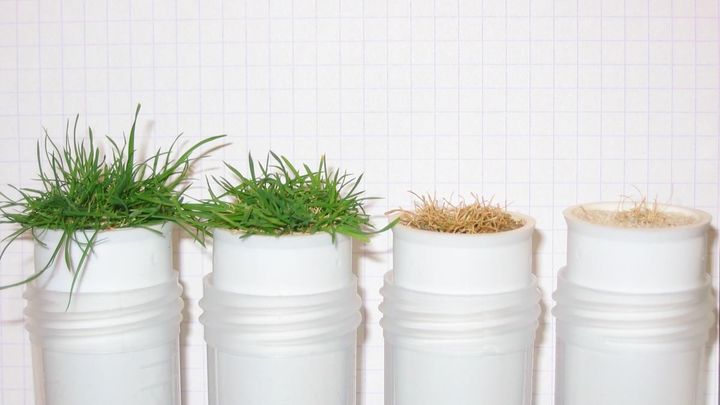Have you seen turf that ran out of potassium?
 Penn A1 creeping bentgrass grown from seed in soils with decreasing amounts of K.
Penn A1 creeping bentgrass grown from seed in soils with decreasing amounts of K.It’s not pretty. In fact, the grass gets horrendous in a hurry when it runs out of potassium (K). Which is why, as a turfgrass manager, one wants to make sure the grass is always supplied with enough K.
The MLSN guidelines are an excellent way to do this, because they make a fertilizer recommendation for K (and for all the other macronutrients and secondary nutrients, for that matter) that considers how much of the element the grass is expected to use and adjusts that based on site-specific soil conditions.
I’ll explain how this works to answer an interesting question that I received a few days ago. This is in reference to K.
Shouldn't it have moved more? How do I effectively get that number up without over applying?
— Planterra Turf (@planterraturf) August 3, 2017
The usual conversion from pounds per acre to parts per million (ppm) is to divide by 2, so I’ll guess that the soil test was about 24 ppm (below the MLSN guideline of 37 ppm) and after application of 175 lbs K (I’ll assume this is elemental K rather than K2O for the purposes of the calculation) the soil is now at 26 ppm. Addition of 175 lbs K/acre is about 20 g K m-2.
The questions are “shouldn’t it have moved more?” and “how do I effectively get that number up without over applying?”
That’s a two part question, and I’m going to give a three part answer.
First part – it would have moved more if the soil could hold the K, but when the soil can’t hold much K, the soil test is always going to be low. I think it is useful to remember that when one adds fertilizer, one does not simultaneously increase the soil’s ability to store that fertilizer. This is especially true on a low cation exchange capacity (CEC) sand, where one could get a much higher CEC by letting the organic matter increase in the rootzone. I’d rather manage a sand rootzone in that climate by keeping organic matter relatively low, and then make up for that by adding low rates of fertilizer on a regular basis. So should it have moved more? Only if the soil had a relatively high nutrient holding capacity.
Second part – how about getting the number up? MLSN takes care of this. If this was bentgrass, I’ll pick a number and say the annual N might be 30 g m-2 (6 lbs/1000). Bentgrass will use about half as much K as it does N, so we can estimate K use at 15 g. If this is ultradwarf, I’ll say annual N may be 23 g (4.5 lbs) and ultradwarf will use K at about 66% the amount it does N, so we get a K use estimate of 15 g again. But this soil has only 24 ppm K – that is below the minimum guideline, so in addition to recommending 100% of the K the grass can use, the MLSN calculation is going to add some extra K. In this case it will be an extra 3 g (that’s the difference between 24 ppm and 37 ppm assuming a 6 inch soil depth), so the total MLSN minimum K recommendation will be 18 g of K (3.6 lbs).
Third part – do you notice how I completely avoided anything about “getting the number up”? That’s because I am not especially concerned about what the soil test number is. I want to have good grass, and to do that I want to be 100% sure that the grass is supplied with all the K it can use. If I make an estimate of how much K the grass will use at my site, and then adjust it for the amount of K in the soil, I will be sure to get a K fertilizer recommendation that is 100% of what the grass can use, plus some extra if the soil is low in K. That’s what MLSN does. It is not about trying to hit certain optimum numbers in the soil. It is about making a site specific fertilizer recommendation based on how grass will grow at your site, and in your soils, to ensure the grass will be supplied with 100% of what it can use, while still keeping a buffer amount of that element untouched in the soil.
I’ll add in a fourth part too. Because grass running out of K would be a catastrophe, and because the grass uses so much K, it is easier to make these calculations in terms of N:K fertilizer ratios, rather than actually working through the calculations that I’ve described in detail previously. If the soil test is below the MLSN minimum for K, I’ll recommend an N:K ratio of 1:1 (or 1:2 in the case of seashore paspalum). That supplies more K than the grass can use, and one expects the soil K to slowly increase. Most importantly, one can be 100% sure that even though the soil is low, the grass is being supplied with considerably more K than it can possibly use. Once one gets above the MLSN guideline for K, I’ll bring that ratio down to something closer to the same ratio the grass uses (N:K of about 2:1 for bentgrass and other cool-season grasses, about 3:2 for bermuda and zoysia, about 1:1 for seashore paspalum). And when the soil is way above the MLSN minimum, then I’ll drop the K recommendation even more.